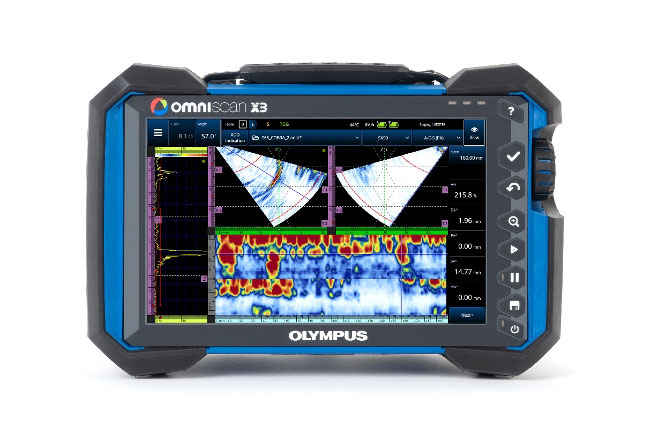Launched at the end of 2019, we designed the OmniScan™ X3 phased array flaw detector to be a powerful, easy-to-use phased array ultrasonic testing (PAUT) tool. Its versatility—including the TFM inspection method—gives inspectors the confidence they need in their decision making.
As a long-standing user of our NDT equipment, the Italian Institute of Welding—Istituto Italiano della Saldatura (IIS)—was among the first to use the OmniScan X3 flaw detector. The IIS consists of a nonprofit association and three limited companies, which provide certification (IIS CERT), training (IIS PROGRESS), and services (IIS SERVICE) for engineers across Italy and abroad.
Simone Rusca, head of the training controls and inspections area at the IIS, is responsible for organizing trainings. He explains: “The IIS started its first training course in 1951. Currently, we train around 1000 people per year: welding engineers, welding inspectors, NDT operators level 1–3, etc. Our course attendees come from a range of different sectors; the oil and gas industry is a key sector, but also construction, railways, automotive, naval, aeronautics, and aerospace.”

“We provide training in a range of NDT methods, for example those described in ISO 9712, [qualification and certification of NDT personnel]. These include penetrant testing, magnetic particle testing, radiographic testing, and, of course, ultrasonic testing—both with traditional techniques and advanced testing techniques like phased array or time-of-flight diffraction (TOFD) ultrasonics.”
The Importance of Training with Advanced Equipment
The IIS has been using Olympus equipment for about 20 years. Mr. Rusca comments, “We always want to use state-of-the-art equipment for our training, as this greatly benefits our attendees. This includes the OmniScan X3 but also new elements, probes, and software provided by Olympus.”
“Our NDT specialists are very happy and satisfied with the new equipment. We currently use the X3 with two different probes: a 32- and a 64-element linear array. We use both phased array and full matrix capture (FMC), and we generally use this equipment to show to our attendees the sensitivity and ease of use of these new techniques and equipment. The feedback from the course attendees, but also from our trainers, is very positive—the equipment is great for improving their skills.”
“Another key benefit for us,” Mr. Rusca continues, “is the versatility of the OmniScan X3 to handle different applications. The people who attend our courses usually work on many different components, indications and defects—and the OmniScan X3 is very fit for this kind of versatility.”
Teaching TFM
The OmniScan X3 flaw detector fully supports TFM. Inspecting components with the TFM brings better clarity and resolution for improved detection of smaller defects, such as early-stage high-temperature hydrogen attack (HTHA). The OmniScan X3 flaw detector can display four TFM modes at the same time, which facilitates flaw interpretation and sizing.

OmniScan X3 flaw detector with TFM
Regarding the use of the TFM, Mr Rusca says: “We use the TFM in our training, and the technicians are very happy and satisfied that this is now available on the X3. However, the key challenge for new methods like the TFM is that it’s not well standardized yet, so it’s often difficult to give a specific answer because we don't have internal comparisons between a TFM result and a reference procedure. Nevertheless, in absolute terms the sensitivity is very good.”
A Strong, Collaborative Relationship
The close collaboration between Olympus and the IIS is mutually beneficial. The IIS has a large number of highly qualified NDT inspectors with a lot of theoretical and practical knowledge. Their input and understanding of the field of NDT and the equipment helps Olympus understand their customers’ needs better.
Mr Rusca adds: “I think this relationship demonstrated a great match of excellence in training and excellence in instrumentation. We are always looking at new technologies, new solutions, and hints to improve NDT methods—and we greatly value Olympus’ input.”
Related Content
Top 3 FMC/TFM Enhancements of the New OmniScan X3 Flaw Detector Explained
TFM and Other Major Advantages of the OmniScan X3 Flaw Detector for NDT Inspectors—A Customer Review
